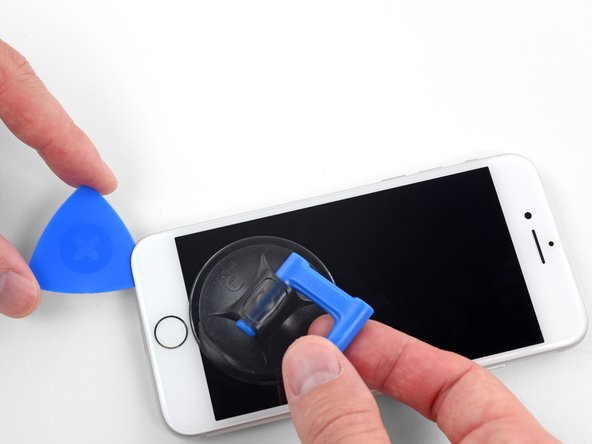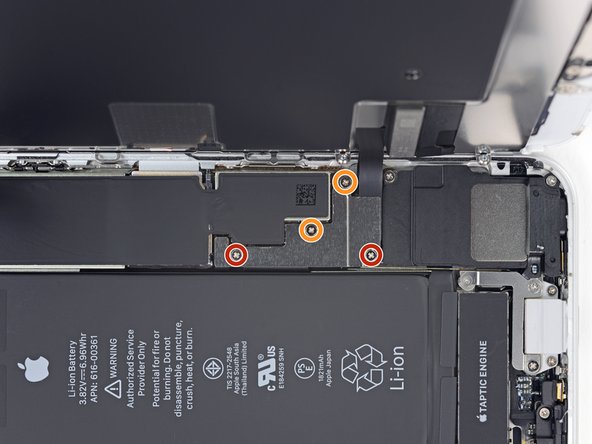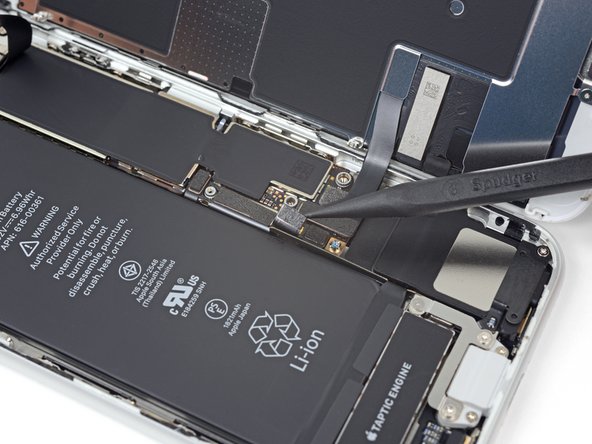iPhone SE 2020 Wi-Fi Diversity Antenna Replacement
Duration: 45 minutes
Steps: 28 Steps
Use this step-by-step guide to swap out the Wi-Fi diversity antenna and flex cable on your iPhone SE 2020. It’s a straightforward way to tackle those annoying connectivity hiccups.
Step 1
Before diving in, make sure to drain that iPhone battery to below 25%. A fully charged lithium-ion battery can be a bit dramatic and might just throw a tantrum if it gets punctured.
Don't forget to power down your iPhone before you start taking it apart. Safety first, right?
Cracking open your iPhone’s display means those waterproof seals will lose their powers. If you’ve got fresh seals, awesome—swap them in before you wrap things up. Skipping the new seals? Just keep your phone away from pools, sinks, and surprise rainstorms.
- Kickstart your repair journey by unscrewing those two pesky 3.5 mm pentalobe screws located at the bottom edge of the iPhone. You've got this!
Step 2
Be careful not to push your pick in too deep, or you might end up causing some damage. It's a good idea to mark your pick to keep things safe.
Feel free to mark other corners of the pick with different measurements to give yourself some extra guidance.
Another trick is to tape a coin about 3mm from the tip of your pick to create a helpful barrier.
- Grab your opening pick and measure 3mm from the tip. Use a permanent marker to mark that spot. It’ll help guide you when you’re making your move—precision is key!
Step 3
The next three steps walk you through using the Anti-Clamp, a handy tool we came up with to make opening your device way easier. If you don’t have an Anti-Clamp handy, just jump ahead three steps for another way to get it open.
For the full scoop on how to use the Anti-Clamp, check out this guide.
If your iPhone’s surface feels too slick for the Anti-Clamp to grip, no worries — just slap on some tape to give it a bit more traction.
- Grab the blue handle and pull it backward to unlock the Anti-Clamp’s arms.
- Slide those arms over either the left or right side of your iPhone.
- Place the suction cups near the bottom edge, just above the home button—one on the front and one on the back.
- Give the cups a good squeeze to create suction on the spot.
Step 4
- Push the blue handle forward to lock the arms in place.
- Twist the handle 360 degrees clockwise, or until the suction cups start to stretch out.
- Keep an eye on those suction cups! If they start to drift apart, just loosen them a bit and realign the arms so everything stays nice and even.
Step 5
Take it easy – no need to go full force. Turn just a quarter turn at a time, and give it a minute to settle in between each turn. Let the Anti-Clamp and some patience work their magic.
You can also try using a hair dryer, heat gun, or hot plate—just be careful, as too much heat might harm the screen or the battery inside.
If the Anti-Clamp isn’t opening up enough, warm the spot a bit more and twist the handle a quarter turn to help things along.
- Warm up that iOpener and slide it through the arms of the Anti-Clamp like a pro.
- Bend the iOpener so it rests comfortably on the bottom edge of your iPhone.
- Take a breather for a minute to let the adhesive chill out and create a little opening gap.
- Gently slide an opening pick into that gap you just made.
- Feel free to skip the next three steps; you've got this!
Tools Used
Step 6
Up next: three steps to skillfully pop off the screen using a trusty suction cup. Let’s get that display moving!
- Warming up the lower edge of your iPhone is a smart move to loosen that pesky adhesive holding the display in place, making it way easier to pop it open.
- Grab a hairdryer or whip up an iOpener, and give that lower edge a cozy 90-second heat treatment to soften the adhesive beneath. You're almost there!
Tools Used
Step 7
Make sure the suction cup steers clear of the home button — if it overlaps, it won’t create the tight seal needed to lift the front glass properly.
- Stick a suction cup on the lower part of the front panel, right above the home button, and get ready to lift!
Step 8
That adhesive holding the screen down is seriously tough—getting that first little gap open takes some muscle. If you’re struggling to pry it open, try heating the edges a bit more, then gently rock the screen up and down to soften the glue until you can slip your tool in. You got this!
- Grab the suction cup and gently pull up with steady pressure. You’re looking to make just enough space between the screen and the frame to get things started.
- Now, slide an opening pick into that little gap. Keep it steady, you’re almost there!
Step 9
Take it easy when you're working on the top edge of the display—it's held in by some plastic clips that are a bit delicate. If you're not careful, they might snap, so just give it some gentle TLC. If things get tricky, don't hesitate to schedule a repair.
- Gently slide the opening pick along the left side of the phone, starting from the bottom edge and moving up towards the volume buttons and silent switch, carefully loosening the adhesive that keeps the display in place.
- Pause when you reach the top left corner of the display.
Step 10
Careful now! There are some sensitive cables hanging out along the right edge of your iPhone. Avoid slipping your pick in this area—it could lead to some unfortunate cable damage.
Step 11
Keep your pick insertion under 3 mm to avoid messing with those delicate display cables!
- Pop your tool back in at the lower right corner of the iPhone, then glide it smoothly around that corner and slide it up the right edge to gently loosen the adhesive.
Step 12
Keep the display at a gentle angle—nothing more than 15º, or you might risk putting unnecessary strain on those delicate ribbon cables connecting the display.
- Lift up on the suction cup with a gentle tug to raise the bottom edge of the screen—no need to flex those muscles just yet.
- Grab the little tab on the suction cup and pop it off the front panel like you're peeling off a sticker. Easy does it!
Step 13
- Gently slide an opening pick under the display starting at the top left corner, then glide it along the top edge to carefully loosen the last bits of adhesive holding things together.
Step 14
- Gently slide the display assembly downward a bit (away from the phone's top edge) to pop the clips free from the rear case.
Step 15
Hold your horses before fully separating the display! There are some delicate ribbon cables that are still connected to the iPhone's logic board, and we want to keep them safe and sound.
- Start by gently lifting the iPhone's display from the left side, like flipping open the cover of a book.
- Once you've got the display open, lean it against something to keep it steady while you work your magic.
Step 16
- Take out the four Phillips screws holding down the lower display cable bracket on the logic board. They come in these sizes:
- Keep an eye on your screws throughout the process so each one finds its way back to its original spot during reassembly. Mixing them up can cause serious trouble.
- Lift off the bracket.
- Two screws measuring 1.3 mm
- Two screws measuring 2.8 mm
Step 17
- Take your trusty spudger and gently pop the battery connector out of its spot on the logic board. No need to wrestle—just a gentle nudge.
- Give the battery connector cable a slight bend away from the logic board. This keeps it from sneaking back into its socket and powering up your phone mid-repair. Safety first, no surprises!
Tools Used
Step 18
- Take your trusty spudger and gently pop the lower display connector out of its socket—think of it as giving your phone a little encouragement to let go.
- When reconnecting, start by pressing down on one side of the connector until you feel or hear a click, then do the same on the other side. Skip pressing the middle—trust us, that’s where connectors go to get bent and never recover. Line it up just right to keep everything smooth!
Tools Used
Step 19
- Gently use the pointy end of your spudger to unplug the second lower display cable. Keep it cool and steady!
Tools Used
Step 20
- Unscrew the three 1.3 mm Phillips screws holding the bracket in place above the front panel sensor assembly connector.
- Carefully lift off the bracket.
Step 21
- Gently pop the front panel sensor assembly connector loose using the pointy end of your spudger. You’ve got this!
Tools Used
Step 22
- Take off the display assembly carefully.
- When putting things back together, this is a great spot to stop if you want to swap out the adhesive around the edges of the display.
Step 23
- Time to get those screws out! Grab your screwdriver and remove the three screws that are holding the bracket next to the Taptic Engine:
- One 1.3 mm Y000 screw
- One 2.7 mm Phillips screw
- One 2.9 mm Phillips screw
Step 24
- Carefully take off the bracket.
Step 25
This part of the flex cable is just a bit stuck. If you're having trouble, give it a gentle warm-up with an iOpener or a hair dryer to loosen that adhesive. It'll help you detach the flex cable without any hassle.
- Carefully slide an opening pick between the antenna flex cable and the top edge of the speaker—take it slow, you’ve got this!
Tools Used
Step 26
- Grab your trusty spudger and gently nudge the diversity antenna flex cable away from the logic board. You've got this!
Tools Used
Step 27
- Slide an opening pick underneath the antenna flex cable to keep the socket in place. Nice and steady!
- Now, grab your spudger and carefully use the point to pry up the antenna flex cable and disconnect it from its socket. Keep that opening pick in place to hold everything steady.
- Reconnecting this cable can be a bit tricky, but don't stress! Use your tweezers to hold the flex cable in place so the connector lines up perfectly with the socket. Once it’s lined up, press down gently with the flat side of your spudger until you hear that satisfying click.
Step 28
- Time to put your device back together—just follow these steps in reverse. Make sure to refresh that display adhesive for a snug fit.
- Got old parts? Drop them off at an R2 or e-Stewards certified recycler and keep things green.
- If your fix hit a snag, swing by our iPhone SE 2020 Answers community for tips and troubleshooting. Still stuck? You can always schedule a repair with us.




































































